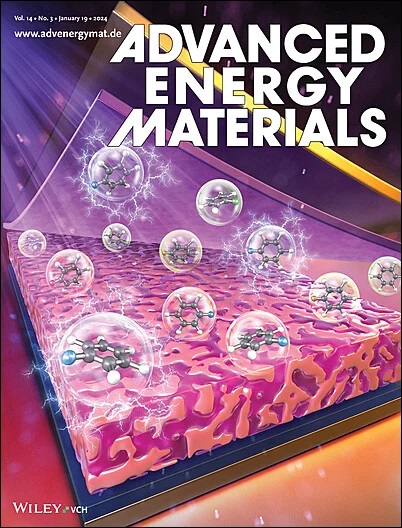Flame Retardant Polyurethane-Based Semi-Interpenetrating Network Electrolyte with Continuous Ion Channel for High-Voltage Lithium-Metal Batteries
IF 24.4
1区 材料科学
Q1 CHEMISTRY, PHYSICAL
引用次数: 0
Abstract
High-nickel cathode materials is known to have high specific capacity but poor stability and safety due to nickel diffusion. While Al-doped high-nickel cathode (NCMA) particles exhibit enhanced stability, their durability under high-charge cut-off voltages remains uncertain. Herein, a polymer electrolyte with semi-interpenetrating network (SIPN) structure is designed for high-voltage lithium-metal battery application. The matrix of the polymer electrolyte is composed of a CO2-derived thermoplastic polyurethane (TPU) and an in situ polymerized polyacrylonitrile (PAN), where the PAN provides strength and the TPU offers excellent high-voltage resistance and abundant ion-complexing sites. With the assistance of additives, the PAN-TPU-based electrolyte performs excellent flame retardancy, wide electrochemical stability window (>5.1 V) and can lead to stable organic–inorganic hybrid cathode-electrolyte interface during cycling. The Li‖PAN-TPU/TEP-E‖Li cell lasts over 3400 h at 0.2 mA cm−2. With the construction of well-connected ion pathway by incorporating of the TPU as binder for cathode and in situ forming the PAN-TPU-based electrolyte. The NCMA@TPU‖PAN-TPU/triethyl phosphate-based electrolyte (TEP-E)‖Li cell shows outstanding performances, which maintains a capacity of 186 mAh g−1 at a 4.3 V charging cut-off voltage, retaining 82% capacity after 300 cycles at 0.5 C. Even at a 4.5 V cut-off voltage, it retains 78% capacity after 200 cycles at 0.5 C.

求助全文
约1分钟内获得全文
求助全文
来源期刊

Advanced Energy Materials
CHEMISTRY, PHYSICAL-ENERGY & FUELS
CiteScore
41.90
自引率
4.00%
发文量
889
审稿时长
1.4 months
期刊介绍:
Established in 2011, Advanced Energy Materials is an international, interdisciplinary, English-language journal that focuses on materials used in energy harvesting, conversion, and storage. It is regarded as a top-quality journal alongside Advanced Materials, Advanced Functional Materials, and Small.
With a 2022 Impact Factor of 27.8, Advanced Energy Materials is considered a prime source for the best energy-related research. The journal covers a wide range of topics in energy-related research, including organic and inorganic photovoltaics, batteries and supercapacitors, fuel cells, hydrogen generation and storage, thermoelectrics, water splitting and photocatalysis, solar fuels and thermosolar power, magnetocalorics, and piezoelectronics.
The readership of Advanced Energy Materials includes materials scientists, chemists, physicists, and engineers in both academia and industry. The journal is indexed in various databases and collections, such as Advanced Technologies & Aerospace Database, FIZ Karlsruhe, INSPEC (IET), Science Citation Index Expanded, Technology Collection, and Web of Science, among others.
 求助内容:
求助内容: 应助结果提醒方式:
应助结果提醒方式:


